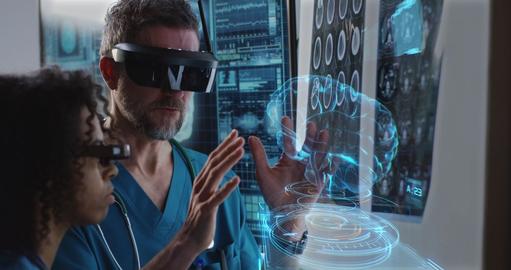- The MedTech industry faces a pivotal moment as it confronts the challenge of adopting transformative technologies amidst a rapidly changing healthcare ecosystem
- Despite progress in other sectors, MedTech has shown reluctance to fully integrate digitalization, potentially hindering its growth and competitiveness
- There have been some notable exceptions such as Medtronic, Siemens Healthineers and Philips
- Many large diversified MedTechs could unlock growth and value by capitalizing on the potential synergies between traditional medical devices and innovative digital solutions and services
- The convergence of digital offerings with legacy medical devices provides opportunities for improved patient care, operational efficiency and R&D innovation
- There is a pressing need for MedTechs to comprehensively embrace digitalization to avoid reduced competitiveness, limited growth, and diminished value enhancement
Forging a path for digital excellence in the MedTech Industry
In an era of rapid technological advancement, the medical technology (MedTech) industry is at a crossroads. While numerous other sectors have enthusiastically embraced digitalization and moved forward, the MedTech sector, barring a few notable exceptions, has been hesitant to embrace these transformative technologies. However, the time has come for large diversified MedTechs to recognize the opportunities that digitalization offers for growth and value creation. The convergence of traditional medical devices with digital solutions and services presents an opportunity for the industry to improve patient care, streamline operations, and drive innovation. Failing to fully integrate digitalization into their operations in a timely way may lead to unexpected consequences, including a shorter window of competitiveness and a struggle to enhance growth rates and augment value. The reluctance of many MedTechs to adapt now could translate into a significant handicap in the rapidly evolving landscape of healthcare technology.
In this Commentary
In this Commentary, we tackle four questions: (i) What is digitalization? (ii) Why is digitalization important for MedTechs? (iii) Which MedTechs have implemented successful digitalization strategies? and (iv) What defines an effective digitalization strategy? In addressing the fourth question, we present a strategy that encompasses 20 'essentials', which are not meant to follow a linear, sequential path. Instead, they are orchestrated by agile cross-functional teams, collaborating and pooling resources. Together, these teams oversee the execution of various elements of the strategy, while assuming responsibility for its overall effectiveness. This approach signals a departure from hierarchical departments and advocates a matrix-style organizational structure characterized by a web of interconnected reporting relationships. This structure goes beyond the confines of the conventional linear framework and incorporates specialized clusters, akin to "nests," each housing unique competencies, spanning multiple dimensions, and encompassing responsibility, authority, collaboration, and accountability.
1. What is digitalization?
Digitalization, also referred to as digital transformation, involves harnessing digital technologies to improve and refine business operations, processes, and services. By integrating digital tools across all facets of an organization, digitalization streamlines workflows, amplifies customer experiences, and achieves strategic goals. This includes automating tasks, utilizing data analytics for informed decision-making, and leveraging cloud computing for scalable and flexible operations. The Internet of Things (IoT) facilitates data exchange through connected devices, while artificial intelligence (AI), machine learning (ML) and large language models (LLM) empower computers to perform tasks requiring human-like intelligence. Virtual and augmented reality (VR/AR) enrich experiences, while cybersecurity measures are important to safeguard digital assets.
2. Why is digitalization important for MedTechs?
Digitalization is important for the MedTech industry since it acts as a driver for significant and positive change. By fully embracing this transformation, the industry develops the ability to use data and analytics to create innovative medical solutions and services. These are built on insights and predictions obtained from large amounts of information. Apart from these benefits, digitalization also affects the core of how clinical operations work. It makes workflows more efficient and frees-up healthcare professionals to focus more on taking care of patients. One significant development is the rise of collaborative telehealth platforms, which play a role in improving the quality and efficiency of healthcare delivery. Additionally, the power of technologies like AI, and ML becomes more evident. These advanced tools, driven by their ability to rapidly analyse vast data sets and make predictions, contribute to breakthroughs in care with the potential to improve patient outcomes while reducing costs.
|
|
The collaboration between smart devices and blockchain technology becomes important in a digital transformation, enhancing patient safety, and ensuring regulatory compliance. As the MedTech sector embraces digitalization, it enables companies to succeed in value-based healthcare environments, which results in quality care becoming more accessible and affordable. This is partly made possible through remote monitoring and proactive interventions that overcome distance. A distinctive aspect of digitalization is the ability to provide personalized care. Focusing on creating solutions and services tailored to individual needs helps to create an innovative environment within MedTechs, which can be leveraged to drive continuous growth and value creation. As digitalization becomes more influential, the MedTech industry should move closer to personalized health, which means care is centered around patients, innovation is continuous, and growth is more certain.
|
|
|
3. Which MedTechs have implemented successful digitalization strategies?
There are several large MedTechs that have successfully leveraged digitalization strategies to gain access to new revenue streams. Here we briefly describe just three. Philips is known for its diverse healthcare products and services, including imaging systems, patient monitoring, and home healthcare solutions and services. They have successfully utilized digitalization by creating a connected ecosystem of devices that capture and transmit patient data, enabling real-time monitoring and personalized care. Their strategy also includes software solutions for data analysis, predictive analytics, and telehealth, contributing to the creation of new revenue streams beyond traditional medical devices. Siemens Healthineers focuses on medical imaging, laboratory diagnostics, and advanced healthcare IT. Their digitalization strategy involves offering integrated solutions that connect medical devices, data analytics, and telemedicine platforms. For instance, their cloud-based platforms enable healthcare providers to store, share, and analyze medical images and patient data, resulting in streamlined workflows and new revenue opportunities through data-driven insights. Medtronic, a global leader in medical technology, offering a wide range of products and services in various medical specialties, has successfully embraced digitalization by incorporating smart technologies into their devices, such as pacemakers and insulin pumps, allowing remote monitoring and data collection. This has improved patient care and given the company access to new revenue streams through subscription-based services for data analytics and remote monitoring.
4. What defines an effective digitalization strategy?
In today’s business climate, developing an effective digital strategy has shifted from being a ‘nice to have’ to a necessity. As MedTechs navigate the dynamic technology landscape, digitalization has become a priority. In this section, we present a 20 'essentials' for crafting and implementing a digitalization strategy. These are not linear, but collectively constitute a path towards a digital transformation for a large diversified MedTech company.
1. Crafting a Cohesive Vision
Digitalization starts with an evaluation of a company's existing products, services, processes, and technologies. This forms the basis upon which a vision and strategic goals are constructed. The main objective here is to align a company's aspirations with the dynamic MedTech landscape, creating a basis for innovation. Digitalization entails more than the integration of peripheral technologies. It is a paradigm shift. The initiation of a digitalization vision depends upon sound long-term strategic objectives. This involves not only envisioning the transformative potential of digitalization within an organization but also projecting its impact, whether that be improved patient experiences, data-driven operational enhancements, or the exploration of new revenue streams. As this vision takes shape, often in the form of a story that everyone in an organization can buy-into, it should steer decisions and guide investments throughout the entire digital transformation process. Further, it provides tangible benchmarks against which progress can be gauged and strategies can be refined. It is important that digitalization goals are aligned to the evolving needs of healthcare. MedTechs should harness the power of digitalization to meet the expectations of patients and adapt to dynamic clinical practices. This requires reconciling digital innovations with a company’s core values. A comprehensive and forward-looking vision (story) functions to safeguard a company's strengths against potential challenges. This first step toward a digitalization strategy serves to position a company for sustainable growth and enduring value creation.
|
|
|
2. Leadership commitment
The significance of securing buy-in from senior leadership teams lies in its assurance of resources, funding, and support, which are vital for the success of such an initiative. The endorsement from executives, beyond being a signal of change, serves as a catalyst for the allocation of both financial and human resources and has a substantial impact on the direction and depth of a digitalization strategy. By wholeheartedly supporting such an initiative, leaders disseminate not only a positive message about the importance attached to digitalization, but they also foster employee engagement, subsequently paving the way for the potential integration of digitalization across an entire company.
|
|
|
3. Cross-functional synergy
Creating cross-functional teams is central for driving change, and should span departments like IT, R&D, operations, marketing, and regulatory affairs. The nature of a MedTech's digitalization strategy requires diverse expertise to successfully release technology's full potential. IT professionals contribute technical knowhow, which ensures the implementation and integration into existing infrastructure. R&D members provide visionary insights, encouraging innovative solutions and services. Operations specialists optimize processes for digital efficiency. Marketers strategize effective communications of digital progress. Regulatory experts ensure compliance and ethical considerations. Each contribution plays a distinct yet interconnected role, fostering collaborative brainstorming, shared goals, and pooled talents within a developing culture of agility and innovative. This approach breaks down silos, and aims to create a unified, technology-optimized future. Cross-functional teams act as the driving force to transform digital potential into a tangible reality.
4. Informed market insight
Market and consumer research is an important element of the strategy, as it uncovers customer needs, preferences, and pain points in digital healthcare. Such insights form the basis for tailored technologies that cater to specific needs, increasing patient engagement and satisfaction. Additionally, a successful digitalization strategy needs to identify and adapt to evolving trends in the digital MedTech sector. This entails monitoring emerging technologies, shifts in consumer behaviour, and advances in medical practices. Equally important is analyzing the competitive landscape to benchmark offerings and drive innovation. When companies are aligned to market dynamics, they are more likely to become digital leaders, fostering continuous improvement and innovation.
5. Technology assessment
Assessing a company's existing technology infrastructure helps to gauge whether a strategy can effectively leverage current investments and assets. Simultaneously, the assessment should uncover gaps and shortcomings. Identifying these informs targeted resource allocation for new technologies that support digital goals. Thus, a technology assessment allows organizations to strike a balance between leveraging existing capabilities and making targeted investments, in pursuit of their digital transformations.
|
|
|
6. Effective digital solutions
An essential aspect of a digitalization strategy involves identifying effective solutions and services. This process entails exploring various facets of an organization to integrate innovations; from improving customer engagement to optimizing workflows. Equally crucial is deploying technologies that improve patient outcomes, diagnoses, treatments, and monitoring. This stage also identifies potential revenue streams derived from new digital solutions and services, like remote patient monitoring, telemedicine, data analytics, and AI diagnostics, which strengthen existing offerings.
|
|
|
7. Partnerships
Engaging in collaborations with technology companies, start-ups, and various stakeholders creates opportunities for synergistic growth. Such partnerships enable enterprises to tap into diverse expertise, gain fresh perspectives, and access specialized resources, all of which support the development and implementation of digital solutions and services. Collaboration facilitates knowledge and resource pooling, enhancing innovation cycles and ensuring a comprehensive transformation of healthcare services. Simultaneously, acquisitions can enhance in-house capabilities. Exploring the acquisition of companies possessing relevant digital competencies or disruptive technologies offers a potential competitive edge. Such moves can help with assimilating novel technologies and developing a culture of innovation. Acquisitions can assist companies to position themselves as key players, advancing their digital health agenda and solidifying their position in an evolving industry.
8. Data management and security
Enhancing data management entails developing and implementing robust protocols. This involves refining data collection procedures, enforcing privacy and security measures, and adhering to healthcare regulations like the US Health Insurance Portability and Accountability Act (HIPAA) and the EU General Data Protection Regulation (GDPR), which safeguard patient data from breaches or misuse. Such measures establish a foundation for data management and security and help to foster stakeholder trust. Compliance with regulations like HIPAA and GDPR should not simply be viewed a legal obligation, but also as a moral commitment when handling sensitive patient data. Such a proactive stance strengthens a company's reputation for data integrity and helps to avoid legal repercussions.
9. Technology roadmap
A technology roadmap is a blueprint charting a course toward enhanced efficiency, patient-centric care, and heightened competitiveness. Beyond action planning, it provides clarity and purpose in navigating technological advancements. It consolidates an enterprise's digitalization efforts by integrating initiatives with timelines and resources, thereby establishing a framework for goal setting and assessment. Such planning assists timely project execution and supports the rationale for digitalization with measurable benefits. With a well-structured roadmap, stakeholders can appreciate how digital initiatives improve operations, trigger innovation, and enhance patient outcomes.
10. Pilot programmes
Pilot programmes serve as incubators and evidence-based validators for innovations, offering a means to test and enhance digital solutions before they are fully implemented. Such initiatives provide tangible evidence to support an enterprise's commitment to a digitalization strategy. Pilots offer concrete proof of an enterprise’s commitment to its digitalization strategy. Each programme should concentrate on specific solutions and establish a controlled setting for gathering user feedback, which constitutes an on-going effort to refine functionality. Additionally, pilots demonstrate a commitment to user-centric offerings by proactively tackling challenges, thereby improving the chances of successful, large-scale digital deployments.
11. Scalability and integration
Establishing scalability and integration capabilities is important for MedTechs to realize their digital transformation. As healthcare technology landscapes evolve and organizational needs change, the ability of digital solutions to scale and integrate with existing structures increases in importance. Ensuring these attributes contributes to a digital transformation. Scalability emphasizes a company’s adaptability to evolving demands. A scalable digital solution that expands in scope without sacrificing functionality invokes confidence. Further, integrating novel solutions and services with existing systems signals operational intelligence, which adds credibility to the digital transition. When digital solutions merge with legacy structures, they reflect an alignment of traditional expertise and cutting-edge technology. Emphasising scalability and integration involves anticipating future requirements and aligning digital strategies with longer-term organizational objectives.
12. Change management
By supporting a mindset that views digital technologies as enablers rather than disruptors, companies demonstrate their commitment to progress and cultural change. Implementing change management acknowledges the importance of cultural shifts and affirms an intent to embrace digital technologies holistically and sustainably. It acts as the vehicle, which guides an enterprise through transformation, and ensures stakeholder support for technological evolution. Through communication, training, and engagement policies, enterprises lay the groundwork for digital adoption, and smooth technology integration. This strengthens the case for change and demonstrates an organization's commitment to fostering an innovation-receptive environment.
13. Training and skill development
Central to a successful digitalization strategy is an investment in training and skill development. This underlines an organization's commitment to harnessing and effectively utilizing the transformative potential of technology. By training, corporations equip their employees with capabilities required to support digital solutions and services. Training bridges the gap between skill shortages and technological advancements. Empowering employees with the capacity to navigate digital technologies positions an enterprise for a successful transition, by a process that reconciles change with employee growth. Training reinforces the notion that digitalization is not just an operational enhancement but also a means to cultivate a workforce with capabilities, which contribute to operational excellence and sustainable expansion.
14. Regulatory adherence
Regulatory compliance is an important feature of a digital shift, as it demonstrates a company's commitment to upholding the highest standards of patient care and industry excellence. It shows that transformation is about embracing the future with integrity by ensuring that an enterprise’s innovations are synchronized with the values underpinning medical practice. Adherence to regulatory standards is a declaration of an organization's commitment to patient safety and industry integrity. By ensuring all digital solutions and services adhere to rigorous medical regulations, corporations strengthen their case for digitalization within ethical and legal boundaries. Demonstrating adherence to medical regulations and industry benchmarks reinforces a new digital strategy as a responsible and trustworthy pursuit and showcases an organization's commitment to delivering technologies that both innovate and enhance patients' therapeutic journeys while respecting established medical protocols.
15. Market communication
Crafting a communication strategy is important as it underlines an organization’s commitment to transformation. Employing a variety of smart communication methods to describe the benefits of new digital offerings enables MedTechs to garner support from stakeholders and thereby strengthen their market position. By aiming at healthcare professionals, investors, payers, patients, providers and other stakeholders, these messages inform and persuade by highlighting the tangible benefits they bring to patient care, operational efficiency, and industry progress.
16. Feedback loop and iteration
Stakeholder feedback can be used to enhance digital solutions and services. By engaging users and patients, healthcare technologies can be tailored to cater to specific needs and preferences, fostering a user-centric design ethos. This collaborative approach identifies bottlenecks, deficiencies, and possible enhancements, which contribute to efficacious digital solutions and services. Moreover, stakeholder involvement helps to ensure a company's technological endeavours support broader healthcare goals, enhancing the overall quality of care. Iteration should be synonymous with evolution. Regularly integrating feedback to enhance the functionality of digital offerings enables an enterprise to adapt to market challenges and healthcare advancements.
|
|
| 17. Performance measurement
Effective evaluation of a company's digitalization strategy demands the use of key performance indicators (KPIs). These serve as a compass to assess the impact of digital solutions across patient outcomes, operational efficiency, and business expansion. By selecting relevant KPIs, MedTechs can show stakeholders the tangible effects of their digitalization strategy. These quantifiable metrics offer a lens to observe enhanced patient care, rectify operational inefficiencies, and decipher trends in business growth.
|
|
|
18. Fostering a culture of continuous innovation
An effective digitalization strategy relies on fostering a culture of perpetual innovation, which is essential to maintain a market-leading position. Such an approach encourages the creation, implementation and refinement of smart technological solutions and services. It equips MedTechs with the agility to quickly embrace emerging trends, capitalize on novel prospects, and tackle unforeseen challenges. Further, a culture of continuous innovation encourages an executive mindset that perceives setbacks as opportunities and views technology as evolving tools to improve patient care and operational efficacy.
19. Adaptation to market changes
MedTechs must rapidly adjust their digital strategies to match prevailing technological trends, regulations, and market dynamics. These ever-changing elements emphasize the need for a proactive, flexible digitalization approach that can swiftly adapt. By staying ahead of shifting trends, businesses are better positioned to leverage emerging technologies and provide solutions for evolving market needs. Navigating regulatory changes is equally important. Balancing compliance with innovative solutions ensures the integration of digital offerings in a dynamic healthcare setting. Flexibility should extend to market fluctuations, aligning digitalization strategies with customer demands and competition. This not only helps a company to navigate volatile markets but also positions it as an agile player, primed for change and enduring growth.
20. Embracing longer-term sustainability
For MedTechs, it is important that their digital strategies align with their principal longer-term objectives. Instead of solely pursuing immediate gains, this strategy should support a company's core purpose and future aspirations, which are embedded within its day-to-day operations. Such an approach establishes an innovative, adaptable, and resilient framework and strengthens the potential for growth. When a digitalization strategy is aligned with a company’s longer-term goals, it assumes the role of a catalyst for growth by optimizing the utilization of resources, improving brand resilience, and securing a distinct competitive advantage. During constantly evolving technologies and markets, such an alignment provides the capacity for a company to effectively confront challenges and capitalize on emerging opportunities, thereby either moving into, or securing, a leadership position within the rapidly changing market landscape.
Takeaways
In the face of rapid technological evolution, the MedTech industry finds itself at a crucial juncture. While other sectors have embraced digitalization, many large diversified MedTechs have been hesitant in adopting these transformative tools. Yet, the imperative is clear: for sizable companies, the present demands recognition of digitalization's potential to drive growth and cultivate value. The fusion of conventional medical devices with digital innovations not only augments patient care but also streamlines operations and encourages innovation. The consequences of delaying this integration are significant. Without prompt action, corporations risk narrowing their competitive horizons and struggling to accelerate growth and enhance value. Failure to adapt may result in a substantial disadvantage in the rapidly changing arena of healthcare technology. It is important for MedTechs that have not already done so, to pivot towards digitalization and transform their challenges into opportunities, ensuring a dynamic and thriving future in an increasingly interconnected world.
|
|
|
|


 2 comments
2 comments







































